The best dog harnesses in 2024, tried and tested
Content is created by CNN Underscored’s team of editors who work independently from the CNN newsroom. When you buy through links on our site, CNN and its syndication partners may earn a commission. Learn more
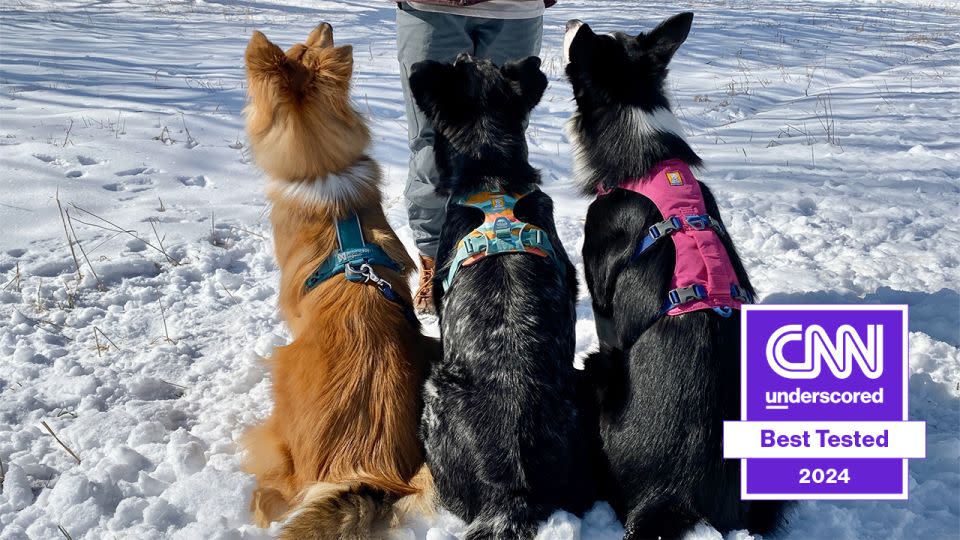
Buying a dog harness is like shopping for women’s jeans — every brand’s sizing is different, and just because your measurements match up with the brand’s measurements doesn’t mean it’ll actually fit. There are also a lot of low-quality options on the market that not only lack durability but also don’t fit most pets correctly. We’d be willing to bet that most people have their dogs in harnesses that are either the wrong size, the wrong design for their build or both.
After testing 12 of the top harnesses available and consulting with professional dog trainers for advice on correct fit and training uses, we came up with the three best harnesses that money can buy.
Non-stop Dogwear Line Harness 5.0
Best dog harness
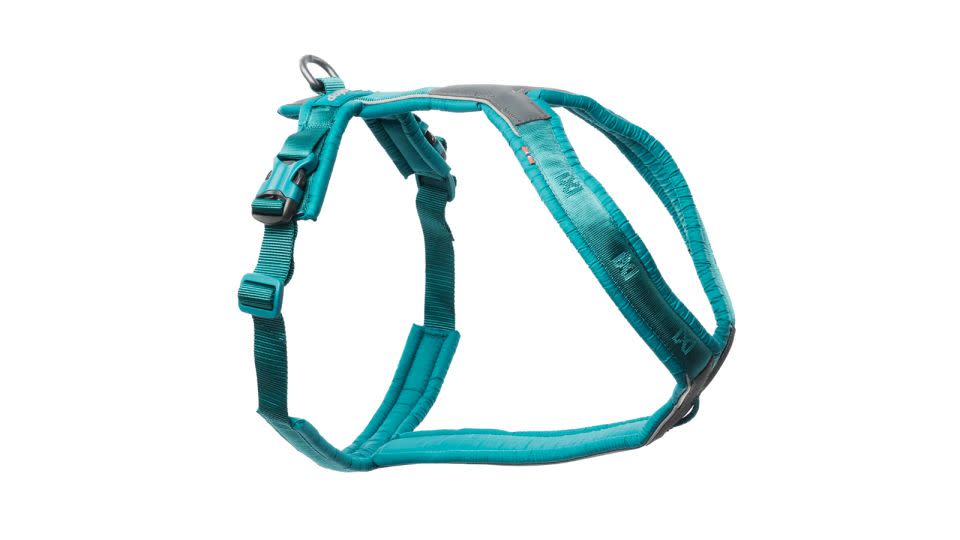
Though Non-stop Dogwear is known for dog sport-focused harnesses, the brand’s Line 5.0 is an excellent choice for an everyday harness for most dogs. It features a padded construction, support for light to moderate pulling, completely non-restricted shoulder movement and 10 sizes to fit nearly any dog.
Ruffwear Flagline Harness
Best harness for big dogs
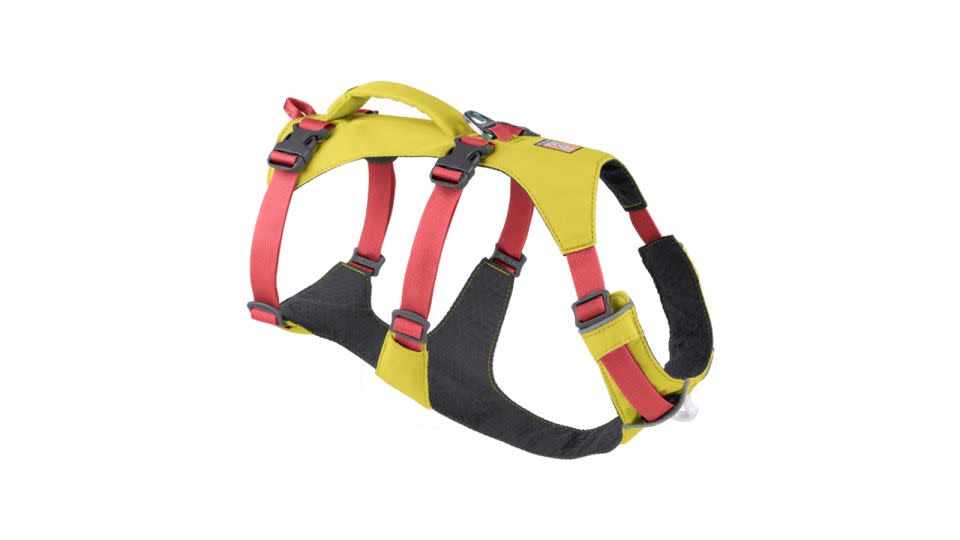
This lightweight but durable harness fits long dogs (longer than they are tall), barrel-chested dogs and oddly shaped dogs the best. The handle is ideal for helping your pup up obstacles on hikes and a proper fit hugs your dog’s body in the right way — without causing any chafing.
Ruffwear Front Range Dog Harness
Best harness for smaller dogs

With a supportive, padded construction and fun color options, the Front Range harness is a fan favorite for a reason. It’s easy to put on, durable enough for pullers and built for pretty good shoulder mobility. We think it’s the best pick for small dogs and dogs who have a more square build (their height and length are proportional).
Best dog harness: Non-stop Dogwear Line Harness 5.0
$65 at Non-stop Dogwear
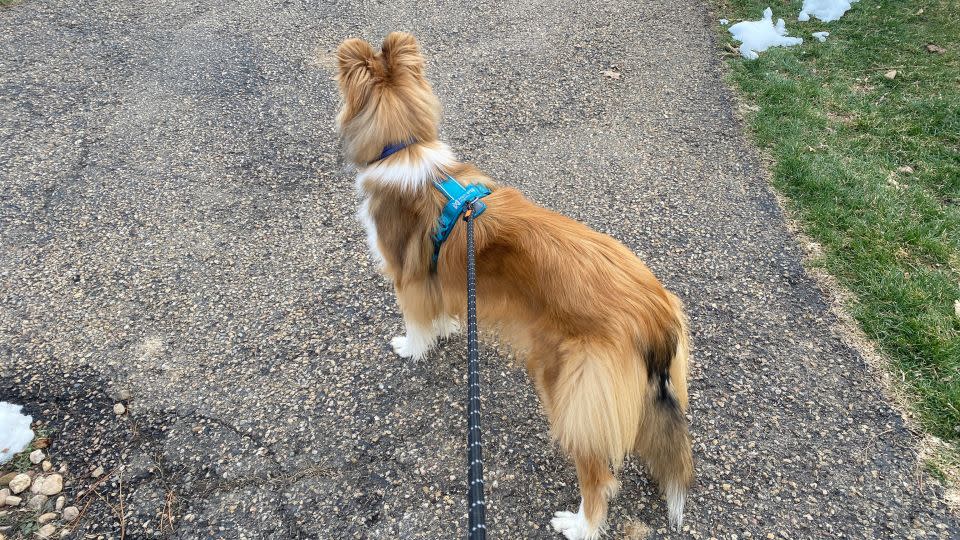
Safety should be top of mind when choosing a dog harness, which means you should make sure the harness you choose actually fits your dog. A good harness should allow full range of motion, enough support for pups who pull without digging into their skin and a snug but comfortable fit that doesn’t slide around too much. A harness that doesn’t fit may cause rubbing and chafing and can put stress on a dog’s joints or spine if they pull too hard on it.
That’s where the Non-stop Dogwear Line 5.0 harness stood out above all the other harnesses we tested. It’s available in up to 10 different sizes (depending on the color you pick), so there are options for toy breeds that fit in tote bags, giant breeds that weigh more than you and everything in between. The Line 5.0 harness had (by far) the most extensive sizing of all the harnesses we tried, with most other options only offering around four or five sizes.
Not only does Non-stop Dogwear have more sizes than any of its competitors, but it’s also rolling out new sizing recommendations based on breed and weight, instead of just your dog’s measurements. During testing, I had trouble finding the correct sizes for my dogs, even when taking precise measurements and looking at sizing charts. Non-stop Dogwear’s new sizing guide takes body shape and structure into account to help you find a better fit.
Using the brand’s old sizing guide, I was sent a size 4 for my 45-pound rough collie, but when I used the new breed-focused guide, I was recommended a size 5, which fit her much better. The new size guide makes it extremely easy to get a size recommendation based on your dog’s weight and breed, so you won’t have to bust the measuring tape out before ordering. For mixed-breed dogs, Non-stop Dogwear recommends inputting the breed your dog’s body shape most resembles for a comfortable fit. The new sizing tool is currently only available on the Freemotion harness, but will be available for the Line 5.0 this spring. The sizing is pretty much the same between the Freemotion and the Line 5.0, so using the tool on the Freemotion page will give you a good idea of your size for the Line 5.0.
During testing, I noticed some gaping at the chest when the harness was not attached to a leash on my extremely barrel-chested border collie mix. This harness definitely fit the purebred dogs and more normally shaped mixed breed dogs I tested on slightly better. For oddly shaped dogs and dogs with deep barrel chests, we recommend the Ruffwear Flagline harness.
Although the Line Harness has tons of sizing options, it doesn’t have as much adjustability as other harnesses. The neck loop can’t be adjusted; only the two side straps that go around your dog’s stomach can change in length.
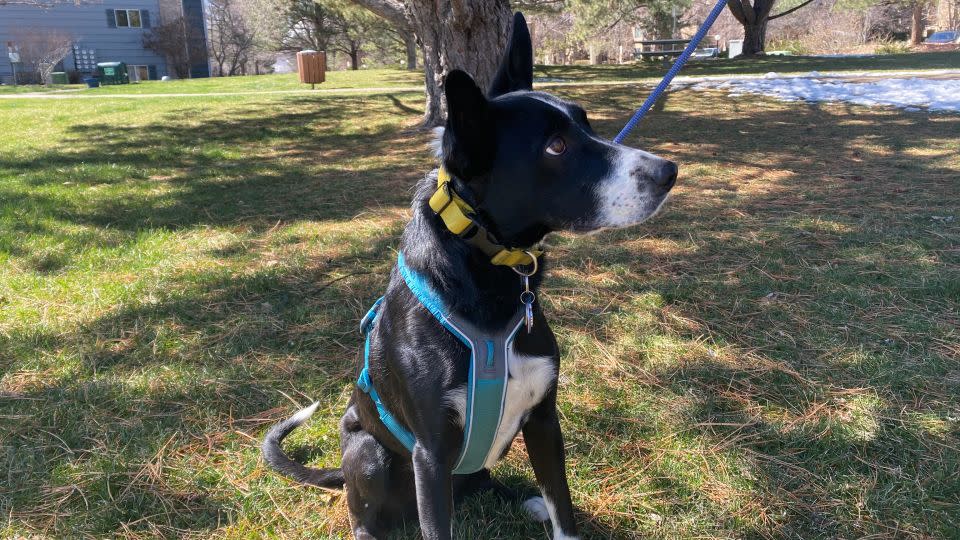
While the un-adjustable neck won’t be an issue for most, it’s not ideal for breeds and mixes with blocky heads like American pitbull terriers, American Staffordshire terriers and rottweilers. If your dog has a large head, the size that fits their neck properly might be difficult to squeeze over their head. My 40-pound border collie/pitbull/amstaff mix, Miso, has a slightly larger head, but I found that sizing up solved this problem. While a size 4 technically fit her, a 5 was definitely a more comfortable fit, especially when pulling it over her head.
Accurate sizing is obviously an important factor, but what’s great about the Line Harness is how it fits dogs when it’s properly sized. It’s designed to have plenty of clearance around the shoulder and armpits, so your dog has a full range of movement without any chafing. During my testing, there was never any fabric or padding rubbing on my dogs’ shoulders or armpits. Most other harnesses I tried would ride up into their armpits, providing an uncomfortable fit, but the Line allowed them to jump up onto fallen trees and full-out sprint without any restriction or irritation.
I also felt comfortable having my dogs pull in this harness — another pro-safety feature of this pick. The padded construction and rounded edges felt supportive on my dogs and didn’t dig into their skin when they pulled. Some other harnesses (like the Blue-9 Balance harness) are made of non-padded nylon material, and are more likely to dig into dogs’ skin and choke them if they pull. Even the un-padded Ruffwear Flagline Harness dug into our tester dogs’ skin more when they pulled significantly. Padded options like the Line 5.0 and the Ruffwear Front Range are the best picks for dogs who tug on the leash. Note that the Line 5.0 harness is most suited to light and moderate pullers — extremely strong pullers should opt for the brand’s Freemotion Harness for ultimate pulling safety.
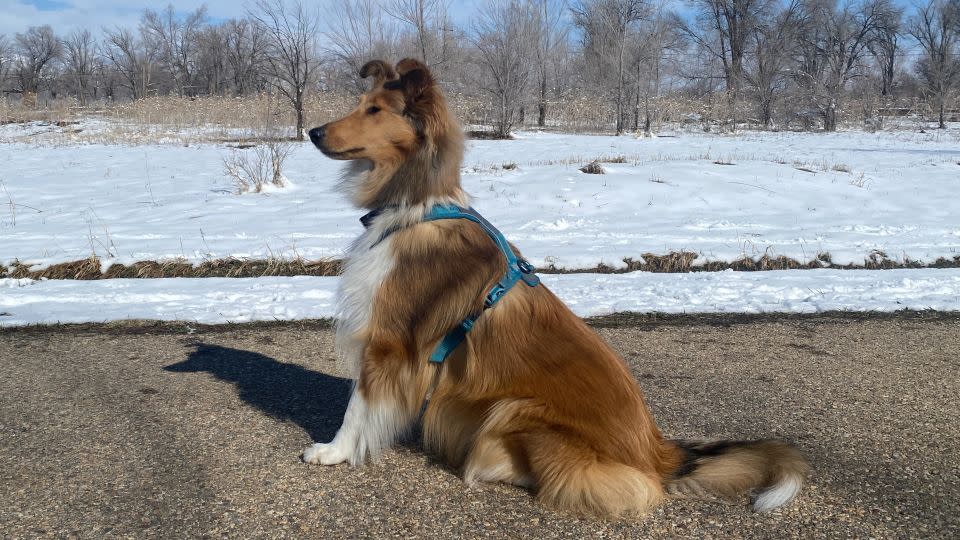
The Line 5.0 also features reflective trim so you can see your dog on nighttime walks, a sturdy back D-ring and an attachment point for a tracking line under the chest. Sizes 3 and up feature an additional front connection point for light pull control or for dragging a long line without getting tangled. Though this specific harness doesn’t have a handle, Non-stop does offer a version with a handle for $75 (a $10 price increase that we don’t feel is worth it unless a handle is on your non-negotiable list).
Non-stop Dogwear makes it easy to return harnesses if the recommended size doesn’t fit your pup. The brand offers free returns for unused items within 60 days of purchase through DHL Express. We do wish the exchange process was a bit easier though — if you want to exchange your harness for a different size, you’ll have to make the return first, then purchase the new size after.
The Line 5.0 harness is a fantastic everyday walking and hiking harness, and can even be used for other activities like skiing, biking, running and canicross for dogs who are light to moderate pullers. Whether you have a high-caliber canine that needs top-of-the-line gear for dog sports, or an older dog who just needs a little pressure taken off their shoulders and joints, the Line 5.0 harness is your pick. This harness comes in a huge plethora of sizes, ensures your dog has 100% free range of motion and gives a supportive, comfortable fit without causing irritation.
Best harness for big dogs: Ruffwear Flagline Harness
$60 at Ruffwear, Amazon and REI
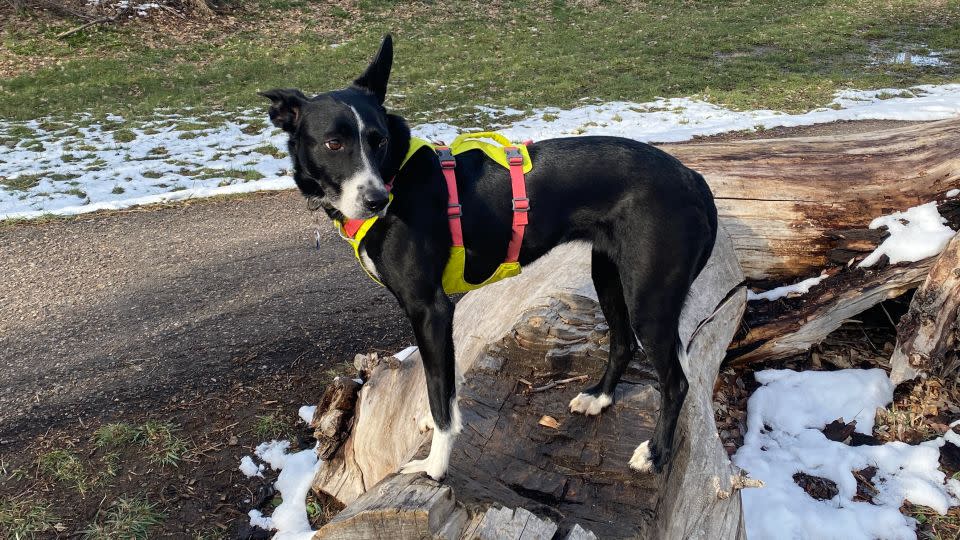
If your dog is very deep-chested, has a big blocky head, is extremely long or has otherwise odd measurements, the Ruffwear Flagline harness is the best option for you. I tried this harness on multiple different dog breeds and mixes, and it offered the best fit for long dogs (dogs who are longer than they are tall).
I tested this harness on a rough collie, a border collie, a border collie mix, a Boston terrier, and a corgi. It fit all of these breeds/mixes well with the exception of the shorter, more compact Boston terrier, since it had too much back length for a comfortable fit. The six points of adjustment truly make this the best pick for dogs who have non-standard proportions. If your dog lacks a strong front, has a deep barrel chest, is long and skinny or has big bulky shoulders in comparison to the rest of their body, the Flagline has enough adjustability to get a solid fit that doesn’t slide around. If your dog is between sizes, you likely can size up while still maintaining a secure fit.
Generally, for large dogs, I’d recommend the Ruffwear Flagline harness over the smaller Front Range harness. This is mostly for the extra back and belly length, thanks to the two extra clips and the additional armpit clearance the Flagline offers. The extra clips mean that it does take slightly longer to put on and take off than the two-buckle harness options I tested, but I think it’s worth it for the longer design and more custom fit.
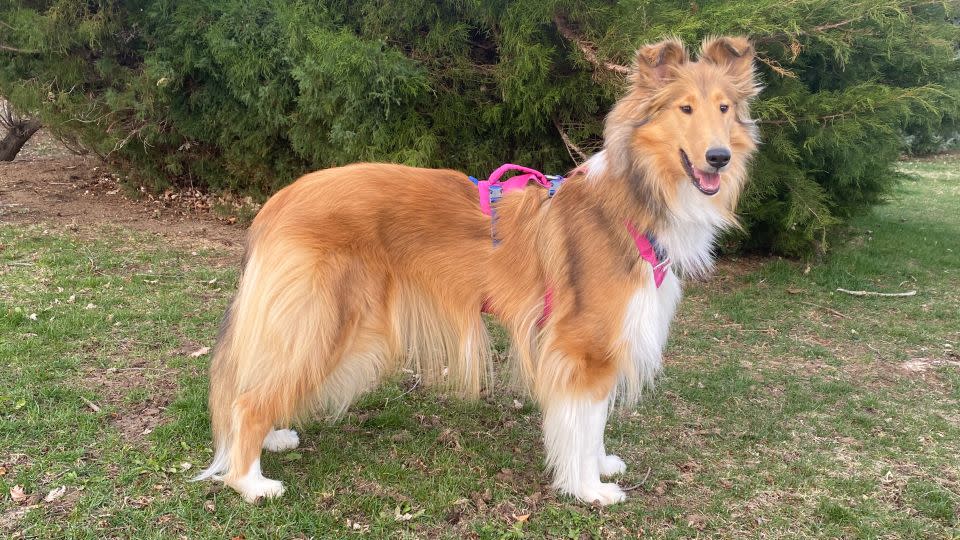
The fantastic adjustability meant that the Flagline didn’t slide around or move back and forth at all during our testing, and though it doesn’t offer quite as much shoulder clearance as our top pick, it still left dogs’ shoulders clear enough for an unrestrictive fit. The minimal, lightweight design of this harness also offers a good amount of front coverage that distributes light pulling evenly. If your dog is a moderate puller, we recommend the Line 5.0 harness for extra support and padding.
The Flagline harness tied with the Line 5.0 harness in the number of connection points. It has three — one in front, one in the middle of the back, and a webbing loop at the very back of the harness — that help dictate your level of control for different activities. The rear webbing loop was helpful for use while running since it allowed the dog to pull into the full front of the harness without it bunching up mid-way.
Aside from testing a new model for this story, I’ve personally owned this harness for my border collie mix, Miso, for almost two years. Aside from some staining earned during muddy hikes, it’s still in nearly perfect condition after almost daily use. Miso is deeply barrel-chested and is longer than she is tall, and this harness features the perfect back length for her so that there isn’t pressure on her spine.
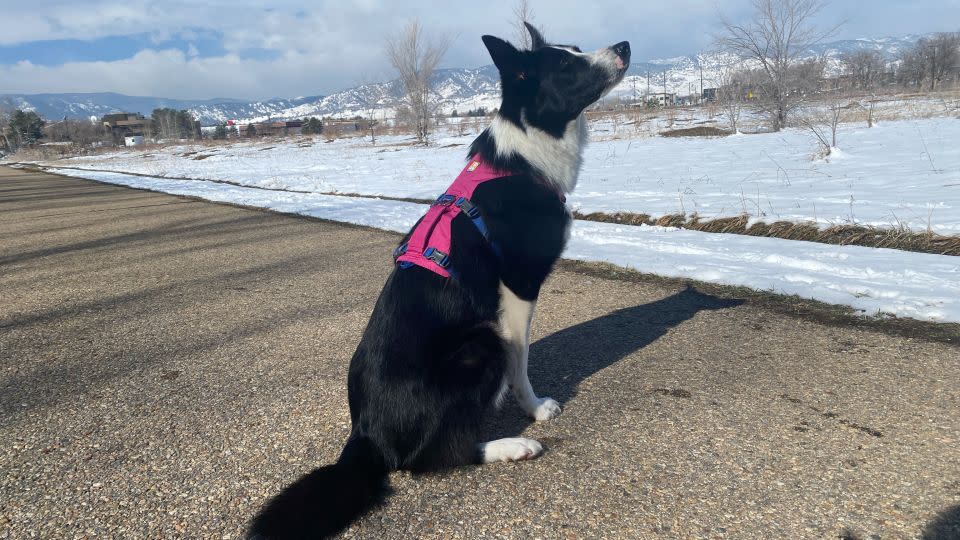
In terms of extra features, I love the handle and the wide belly fabric on this harness — two features that make the Flagline an ideal hiking companion. I’ve used the handle on this harness to give Miso a boost up and down big rocks and to lift her up and down ladders, both on hikes and on our rooftop tent.
If you’re worried that a standard harness might not fit your mixed-breed dog with odd proportions, opt for the Flagline Harness. Not only is it lightweight yet durable, but it also offers enough adjustability for a secure fit. Though it doesn’t have as much shoulder clearance as the Line 5.0 or as much padding as the Front Range, the Flagline is a fantastic middle ground for any (and we say this lovingly) weirdly shaped dogs.
In case the size you order doesn’t fit your dog, Ruffwear offers a 30-day return and exchange policy for unused gear. You’ll be able to return it for a full refund or swap for a different size — all with free shipping. If you purchase your Ruffwear harness through Amazon, you can also utilize its free return and exchange policy.
Best harness for smaller dogs: Ruffwear Front Range Harness
$50 at Ruffwear, Amazon and REI
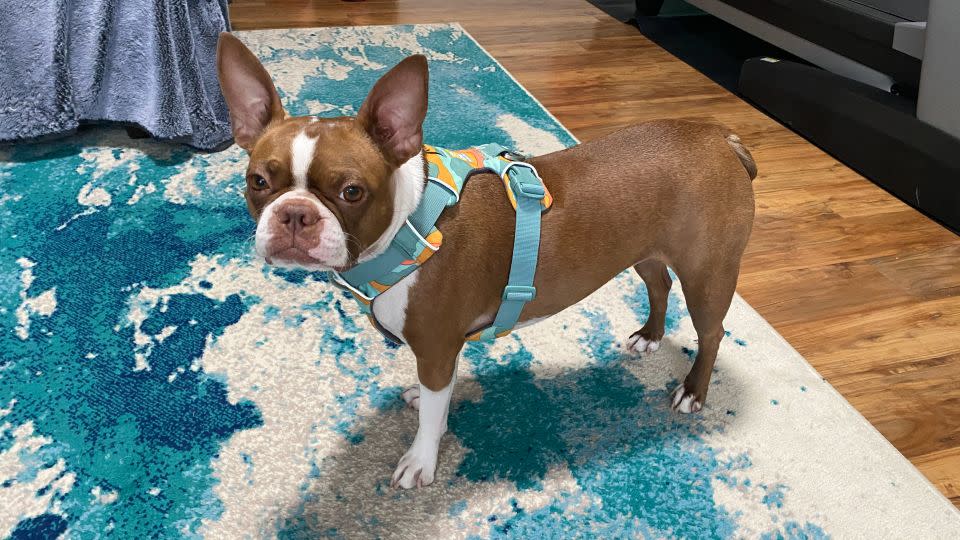
I was skeptical about the Ruffwear Front Range Harness at first, just because it’s so short in length. During testing, even the larger sizes tended to be too short to properly distribute force on medium and large-sized dogs, especially when they had a long build. Even when I sized up, the back length felt too short to properly distribute pull on my rough collie and border collie mix, and it tended to ride up into their armpits.
When I tested it on a friend’s Boston terrier, however, I realized that it’s an excellent option for dogs who are less than 40 pounds and more square in shape than rectangular. If you have a corgi, dachshund or other long breed, go for the Flagline instead, even if they’re technically small. However, if your dog is small and boxy like a Boston terrier, a bulldog, or any of the small terrier breeds, the Front Range’s short length will probably fit great. Because it’s a shorter harness than the other two top picks, it doesn’t offer enough armpit clearance when it’s slightly too small and may cause chafing if not sized correctly, so I recommend sizing up if your dog is between sizes.
This harness only comes in five sizes in comparison to the Non-stop Dogwear’s 10 sizes, and even the larger sizes tend to be short in the back and belly area, so we only recommend this for smaller dogs that would fit in Ruffwear sizes XXSmall through Small. If you do end up with a size that isn’t quite right, take advantage of the brand’s free 30-day return and exchange policy.
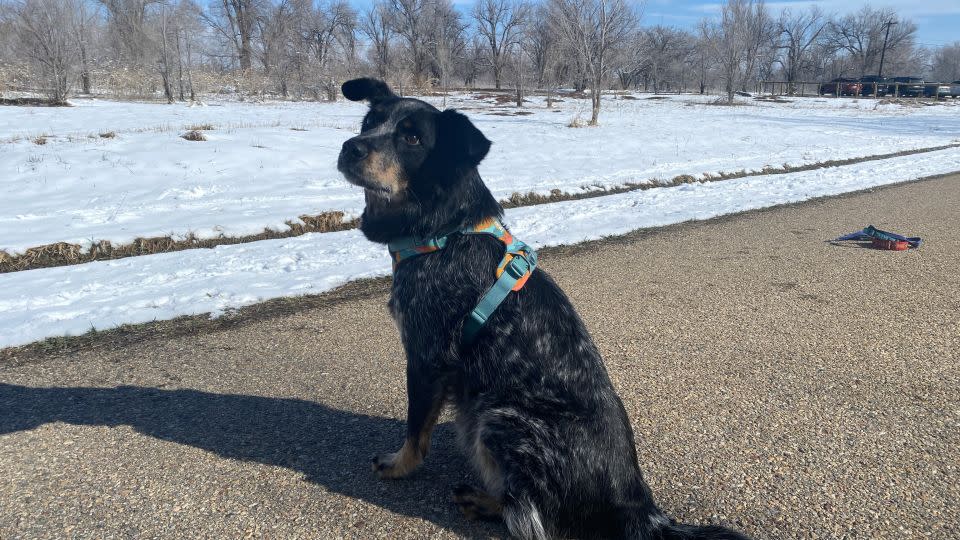
Besides fit, the Front Range Harness stood out from the pack thanks to its durable, heavyweight construction and considerable padding that makes it a good option for pullers — dogs won’t choke themselves by pulling on this harness. The hardware is sound, and it has a reinforced loop in the front for mild pull control or for dragging a long line.
I loved that the reflective trim on this one was significantly more noticeable at night than on the Flagline, and it’s slightly easier to put on, too. Just adjust the neck straps, slip it over your dog’s head and adjust and clip the two side straps.
The Ruffwear Front Range harness is a solid everyday harness for small dogs and dogs with square builds. It’s padded enough at the neck for light to moderate pullers, and the heavyweight material doesn’t slide back and forth while your dog is wearing it. Though it doesn’t have a handle, it does have a durable rear D ring and a reinforced front webbing loop for mild pull control. It also features a secret pocket for dog tags or other identifying info.
For folks looking for a budget option, Ruffwear sells discontinued colors in its Front Range harness at a discount when new colors come out. At the time of publication, the site had five previous seasons’ colors available for $38 in various sizes.
Everything you need to know about buying a dog harness

It’s easy to pop down to the pet store and buy whatever harness catches your eye, but not all dog harnesses are created equal. Fit is of the utmost importance when shopping for a harness for your furry friend, and there are tons of harnesses on the market that don’t offer a safe, correct fit.
That means you’ll not only need to make sure your dog’s measurements match up with the harness’ measurements, but also that you’re picking an option that complements your dog’s conformation, or build.
“Not all dogs are built the same way, so it’s important to look for a harness that offers a lot of adjustment points,” said Devi Do, a professional dog trainer based in Indianapolis, Indiana.
Believe it or not, there are health and safety concerns that come with picking out a harness for your dog. Some harnesses can be restrictive to dogs’ movement and can put stress on their bodies over time.
“I like the harnesses that go fully down dogs’ chests and around the back,” says Kirsten Belinsky, a professional dog trainer, agility instructor and canine conditioning coach. “If they’re going to pull, I’d rather them pull into something that’s safe and well fitting,”
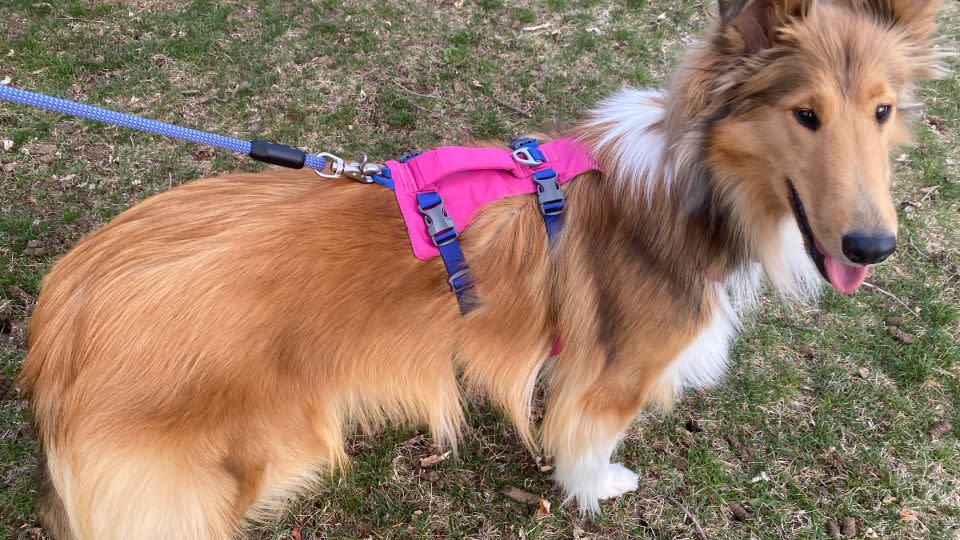
Kara Godebu, a professional dog trainer based in Longmont, Colorado, echoes Belinsky’s opinions, and says that harnesses should not dig into the dog or cross in front of the shoulder blade, and should allow for free movement. “The chest should be a Y-shape, keeping the shoulder clear,” she says. There should also be enough length in the harness that it doesn’t ride up into your dog’s armpits, which can cause chafing.
Godebu recommends checking to ensure your dog’s harness doesn’t “pull off to one side and stays secure when using it.” The harness should also be snug enough that a dog can’t back out of it — especially if they’re a flight risk.
The quality and fit of your dog’s harness are crucial, and unfortunately, most cheap harnesses are not worth your time or money. While it may be tempting to just buy the first harness that pops up on Amazon, many of these budget-friendly harnesses have unsafe or uncomfortable fits and are made of low-quality materials. You’re better off paying more upfront for a durable harness that will last years to come.
What kind of harness is best for dogs who pull?
Plenty of dog owners struggle with dogs who pull on walks, and might look for a harness to fix this issue. Easy Walk harnesses and other options that have straps that connect at a 90-degree angle across dogs’ shoulders have become popular over the last few years for discouraging pulling. However, all of the dog trainers we talked to warned against these types of harnesses and agree that they won’t train your dog to stop pulling.
“These kinds of harnesses are more of a management tool, and they don’t actually teach your dog how to walk nicer on a leash,” said Belinsky. Do posits that since these kinds of harnesses are positioned at the shoulders, they can also cause stress on your dog’s joints. “Yes, it can make pulling harder, but the long-term effects aren’t worth it,” she says.
Godebu agrees. “I am primarily against the ever so popular front hook/’no pull’ harness. These are often not well-fitted and cut across the shoulder; causing orthopedic issues as well won’t truly help a dog stop pulling.”
As a caveat, Do and Belinsky agree that some owners might feel the need to use a no-pull harness in conjunction with training. “No-pull harnesses are designed to make it harder for dogs to pull, but this shouldn’t be used as a replacement for training,” says Do. She says that these types of harnesses can allow owners more control while they teach their dog good leash manners, and can be an option for folks with very large or strong dogs they have trouble controlling until they’re fully trained.
As an alternative to no-pull harness styles, Do recommends well-fitting traditional harnesses that have front attachment points to help redirect pressure when dogs pull. If your harness has an option to attach a leash to both the front and back, connecting to both “can give better control over more boisterous dogs, like reins on a horse,” she says.
How we tested
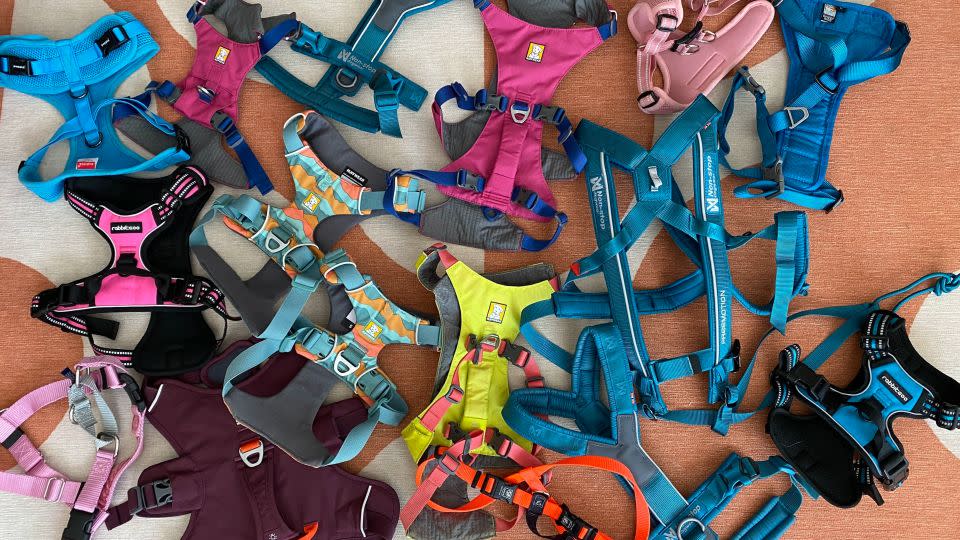
With the help of my two dogs, Miso and Dashi (and all of their neighborhood dog friends, including Tide the border collie, Welly the corgi, Sansa the Aussie, and Mitsu the Boston terrier) we tested some of the most popular harnesses for correct fit, ease of use and adjustability, and more. Here are the tests and features we evaluated on all 12 of the dog harnesses we tested for this article.
Usability
Ease of use: We determined how quick and easy each harness was to put on, take off and adjust on multiple different dogs.
Performance on different coat types: With Dashi the rough collie taking the lead, we determined how well each harness worked for long-coated dogs. We noted when a harness tended to flatten Dashi’s coat, or caused tangling or mats.
Fit and sizing
Brand-recommended sizing: We tried each harness on two to three different dogs that fit the size ranges to determine if the recommended sizes were accurate.
Fit and pulling test: We tried each harness on around four different dogs to determine how they fit differently shaped dogs. We had each dog pull on the harnesses while attached to the leash to see how well it distributed pressure across the body. Harnesses that bunched up, tended to turn or seemed like they were cutting into the dogs’ necks, shoulders or armpits were docked in our scoring.
Shoulder mobility test: We evaluated how much shoulder space each harness gave the dogs, and noted which ones they seemed most comfortable breaking into an all-out sprint in.
Size options: Not every harness is a good fit for every dog, but we preferred brands that catered to small dogs, giant breeds and everything in between.
Exchange policy: Getting a harness in the correct size on the first try can be difficult, even when using a measuring tape. That’s why we gave brands with simple and easy exchanges bonus points.
Design and durability
Build quality: We thoroughly examined the material and hardware of each harness to determine how durable they might be. We noted how well they held up to dirt, rough play and weather over the course of testing.
Portability: We folded each harness down and weighed them to determine how easy they’d be to pack and bring along on a trip.
Number of adjustment points: There are two camps of sizing for harnesses: brands that offer tons of sizes with less adjustability and easy on/off designs, and brands that offer fewer sizes with more adjustability to find the sweet spot of catering to the highest amount of dogs. We looked to find the middle ground between these two options in our top picks.
Number of connection points: The more connection points, the better. We prefer harnesses that have at least a front and a rear leash connection point. Front connection points are great for mild pull redirection or connecting a dragline for off-leash training, and a durable rear D ring is a must for leash walking. We gave extra points to harnesses that had more than two connection points.
Extra features
Extra features: We took note of any extra features the harnesses had, including reflective trim, a handle, padded belly straps and pockets for ID tags.
Price
Online cost: We checked the retail price of each harness and compared them to each other given the performance test results. Considering that fit and durability are of the utmost importance when choosing a dog harness, we found that the best harnesses range between $40 and $70+. In most cases, the prices of the sub-$20 harnesses we tested from Amazon were too good to be true — they all had serious fit or build quality issues that made them not worth the money. You’d likely pay the cost of one of our top picks twice over by buying and replacing multiple cheap options due to the problems we found.
Other harnesses we tested
Blue-9 Balance Harness
$40 at Blue-9
This ultra-adjustable harness has six different adjustment points and is the only harness we tested that allows users to shorten and lengthen the chest and back pieces. This makes it great for long dogs, and it fit a wide variety of dogs during testing. I didn’t see any riding up in the armpits or potential chafing spots on our walks, thanks to the highly customizable fit. It can be somewhat confusing to put on depending on how many clips you leave buckled, and while the low-profile design is portable and works well on longer coats, the nylon material is fairly thin and isn’t very supportive or protective for dogs who pull. If you’re looking for a minimal harness for a dog who walks politely on a leash, the Blue-9 balance is a good pick.
Ruffwear Hi & Light Harness
$40 at Amazon and Ruffwear
This harness is the smaller, lighter sibling of one of our top picks, the Ruffwear Flagline harness. With the same lightweight design, the Hi & Light features one fewer set of clips than the Flagline, making it slightly easier to put on. The downside of losing the extra set of clips though, is that it tended to be too short on most of the dogs we tried it on. It definitely runs smaller than the Flagline, and we found that you may need to size up if your dog is between sizes for more back length and extra armpit clearance to avoid chafing. While we liked the easy on-and-off design and the ultra-lightweight fabric, we generally feel that the Ruffwear Flagline Harness or Front Range Harness are better picks based on your dog’s size.
Ruffwear Web Master Harness
$70 at Amazon and Ruffwear
It’s the choice of avalanche search and rescue dogs for a reason — the Ruffwear Web Master is a heavy-duty harness with reinforced padding and a handle that’s perfect for giving dogs a boost on hikes or hoisting them up and down the ladder of a rooftop tent. It’s incredibly durable, and we tested the previous version of this harness for almost three years with minimal wear and tear. The current version of this harness features upgraded foam for more breathability and flexibility than its predecessor. While this harness is a serious workhorse, it’s probably more than most people need for everyday use. We found that it was too high-coverage for dogs with long coats and was more difficult to put on and take off in comparison to the other Ruffwear options, since it requires you to lift one of your dog’s legs up.
2Hounds Design Freedom No-Pull Harness
From $30 at 2Hounds Design
If you’re 100% set on a no-pull harness, the 2Hounds Freedom No-Pull is a solid option. This isn’t the best choice for most dogs, since the front panel cuts directly across dogs’ shoulder blades and tended to limit mobility more than the other options we tested. If you don’t have issues with your dog yanking your arm off during a walk, don’t opt for this harness. However, if you have a large, powerful dog that would benefit from a durable front clip harness and some pulling control, we recommend the 2Hounds. This harness is incredibly well-made, with durable, thick nylon webbing that would likely hold up for years and a nice velvet-lined belly strap to prevent rubbing and chafing. It also features some seriously heavy-duty hardware. We didn’t love that the brand has different prices for different sizes, but the plethora of available colors (over 30) and sizes (eight, with two different thickness options) makes up for that.
Non-stop Dogwear Freemotion Harness
$110 at Non-stop Dogwear
This heavy-duty harness allows for intense, safe pulling and is specifically designed to distribute force over your dog’s whole body without putting too much stress on their neck or spine. It’s as well-made and durable as our top pick, the Line 5.0 harness from Non-stop Dogwear, but it’s frankly a little overkill to be used as an everyday harness. It didn’t make the cut because of its high price ($110) and how difficult it is to get on and off. It did, however, perform the best in our pull distribution tests, and would make a great pick for dogs who do lots of running, bikejoring, canicross or other high-impact pulling sports.
Rabbitgoo Harness
From $18 at Amazon
We wanted to love this cheap Ruffwear Front Range alternative, but the fit of this harness was wonky on every single dog we tried it on. We tested three different sizes on each dog, and not a single one fit our two main testing dogs correctly. Even in the larger sizes that were too big around our tester dogs’ necks, this harness rode up in the armpits and was way too short to safely distribute force on a dog that pulls. During our tests, it put more pressure on the dogs’ spines than we were comfortable with, and would definitely cause chafing with prolonged use.
Kurgo Trufit Harness
$29 at Amazon
Though it features high-quality hardware and doubles as a (non-crash-tested) car seatbelt, the Kurgo Trufit has a design that doesn’t fit most dogs well — especially those with deep barrel chests. It tended to slide back and forth too much during walks when clipped to the front and the back connection points, and it didn’t lay flat on dogs’ chests or backs during testing.
Puppia RiteFit
From $17 at Amazon
This soft, light harness is a decent, budget-friendly choice for very small dogs and for puppies who haven’t gotten used to a heavier, bulkier harness. We liked that it doesn’t require you to slip anything over your dog’s head and that the wide but soft material around the neck and chest dispersed pulling well in the front. However, we noticed that this harness tended to bunch up in the back when connected to the back D ring, and it didn’t offer enough armpit clearance for even our 20-pound tester dog.
Best Pet Supplies Voyager Harness
$16 at Amazon
While in theory, a step-in harness can be great for dogs that are head-shy, we had fit issues with the Voyager step-in harness — even on small dogs. It rode up in the armpit while also gaping at the chest, and wasn’t shaped properly for any of our tester dogs.
Note: The prices above reflect the retailers' listed price at the time of publication.
For more CNN news and newsletters create an account at CNN.com

